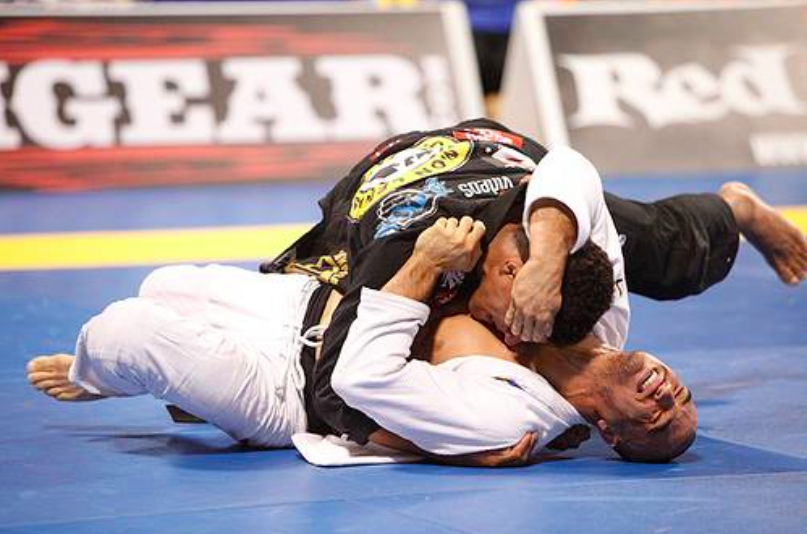Mike “Spider-Ninja” Bidwell is a BJJ Black Belt under Phil Migliarese and Ken Kronenberg (Team Tai-Kai / Balance). Mike is a full time Jiu-Jitsuka, blogger (check out his great blogBJJafter40 and ‘Like’ his Facebook page), freelance writer, content provider, teacher and Ninja-for-hire!
Everyone who trains BJJ knows this experience:
You’re on your back and you have a big guy on top of you and he’s just smashing you with every ounce of his being…his shoulder is driving into the side of your face and you can feel it in your teeth…you can hardly breathe as his torso crushes your chest and you feel like you are breathing through a straw… you’re just hoping he will move or mount you or do something to relieve the pressure…
We have all been there at one time or another. Being on the bottom just sucks…or does it? First off, being on the bottom is very uncomfortable. But then again Jiu-Jitsu isn’t the most comfortable activity after all we choke, arm-bar and twist each other up like pretzels just for fun. So I think you first have to accept that you are going to end up in positions that are simply not comfortable but that doesn’t mean you have to give up either. Nobody wants to tap out because someone got side control.
Think of it this way, when you end up in bottom side control what is the worst thing that could happen? You might tap out if they catch you in a submission. But if you are doing a great job preventing possible submissions and they are just smashing you, what’s the real danger? Unless you have a pre-existing injury, there’s no real danger of getting hurt when someone has side control, so there’s no reason to tap! When someone has side on me I first try to position my body to prevent being submitted, then I take a deep breathe and try to relax my body. When you’re tense and rigid it is easier for the top player to control and move your body. In addition, when you’re tense you burn more energy. Once you take a deep breathe you need to mentally remind yourself to relax and that you’re in control. Then try to position your body so that you can be as comfortable as possible. This is a time to stay focused, keep your wits and stay in the moment. If you start to get anxious and “freaked out” your body might misinterpret this information as “real” threat and create a fight or flight response.
This will cause your heart rate to increase, make it difficult to breathe and quickly cause you to physically and mentally unravel. Remember, bad position isn’t the end of the world. In BJJ we tend to get this mindset where if someone is in a better position (regardless of whether they submit us or not) they are winning. Unless you are keeping points this simply isn’t true. Even in tournaments this isn’t necessarily true…there are top-level guys who have had entire careers built on working from “bad positions”. Remember, it’s only bad if you get submitted! When I was starting my matches from bad positions I would have these ego-flares where I would worry what others (including my partners) were thinking. There I was a BJJ black belt and I would have a purple belt in side control giving me fits. But again this was my ego trying to tell me a different story. You have to let go of the idea that “bad position” equates to failure. It’s never really a failure, even when you tap, because that was just an opportunity to learn.
Tips for surviving on the bottom:
1. Relax and breathe. Remember, your breath is your first point of focus when you’re tired, anxious, etc. Breathing will help you calm down and bring you back to the present moment.
2. When in doubt ask yourself, “Where am I and what do I need to do next?” This will keep you in the present moment and help you to formulate a plan.
3. Look at the clock. How much time do you have left in the round? Maybe you have 30-seconds left so your plan might be to hold on and survive. If you’re 30-seconds in, you need to conserve energy and wait for an opportunity.
4. Don’t tap to position. Unless you have an injury, problem-solve and find your way out. Remember, everything can change in a moment. If you do get submitted it’s not the end of the world, use it as an opportunity to learn!
5. Have solid basics. When you get in a “bad position” this is your opportunity to apply solid, fundamental Jiu-Jitsu. If your basics are weak, your Jiu-Jitsu is weak!
6. Get feedback! If you’re really getting stuck on the bottom and you’re not progressing, talk to your teammates and coaches. A private lesson with your instructor might be helpful.
Control the conversation in your head. It’s easy to fall apart when you’re getting smashed. Believe in your Jiu-Jitsu, control your ego and maintain a positive mindset even when you’re stuck on the bottom – a great lesson on a off the mats!

















